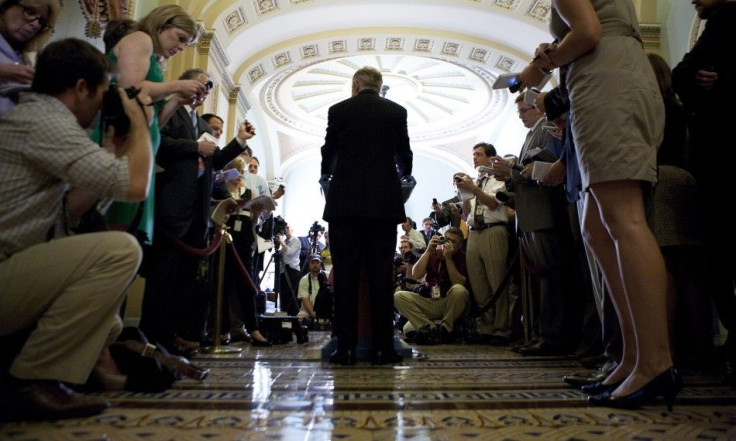America is Broken: Five Ways to Fix the Nation
Analysis

America is broken and needs to be fixed.
It's not broken into a million tiny pieces. But it's certainly cracked.
Consider:
--Standard & Poor's ratings agency has just downgraded the U.S. debt rating from triple-A for the first time ever, citing an unstable political environment as a leading reason for the change.
--America's unemployment rate remains at 9.1 percent, two years after the official end to the Great Recession. Many also believe the situation is worse than that, since others are no longer being reported in official numbers since they've give up hope of finding a job.
--More U.S. citizens are relying upon food stamps than ever before. The U.S. Department of Agriculture says nearly 15 percent of the U.S. population relied on food stamps in May, up 12 percent from the same period one year ago and 34 percent higher than two years ago.
--U.S. debt, at $14.5 trillion, now reaches 100 percent of the nation's GDP, the first time that has occurred since World War II.
But all is not lost for the world's largest economy. Not even close. America can be fixed, and here's five ways it can happen:
1) Create a federal iBank -- a public-private partnership to fund infrastructure investment in the nation. The infrastructure bank, or iBank, can get projects done including repair and building of subways, highways, bridges, dams and waterways without busting the budget.
Such iBanks have already been underway from Europe to China. The idea is pairing federal dollars with private dollars from pension funds and endowments, lessening the federal burden but infusing the economy with meaningful investment to create jobs and long-term sustainability.
Infrastructure built this country in the 20th century, but for some reasons politicians have forgotten in the 21st century that's often the single best place for political investment to occur in terms of benefiting the nation's current and ongoing health and wealth.
2) High speed rail could be a part of the iBank investment structure, but it's highlighted here independently because it's possibly the most critical infrastructure project facing this nation. Its been a signature project of President Barack Obama and it's easy to see that America's rail and transportation infrastructure lags far behind that found in other countries.
The stimulus dollars spent in the government bailout during the recession have shown to have barely worked at all. That's because government has shown in the course of history that massive infrastructure projects like building the Interstate highway system or establishing the Tennessee Valley Authority (electric) put people to work and send America down a sustainable road.
High-speed rail had much momentum before the recession. But after it, states including Minnesota have balked because of costs in the budget crisis -- they don't want to commit matching dollars to get it done. And that's a big mistake, since America is a big country and high-speed rail is a necessity for the 21st century.
3) Bring back the WPA, or Works Progress Administration, or a new program like it. Increasingly the federal government is having to dole out help to its citizens. Note the recent rise in food stamps. Also, the government has extended the period allowed for unemployment benefits two times since the recession.
Why not take a page from America's valued history, and go back to how it was done in the 1930s when during harsh economic times unskilled workers were employed by the federal government to carry out public works projects. Almost every community in America had a park, bridge or school built by the WPA, and many still exist today.
The pay wasn't high, but there's a difference in working for the government and taking a handout from the government for nothing. By changing requirements for federal handouts including unemployment, food stamps and other programs, the government could benefit by getting work in return for its money.
By getting people back to work, at any level at all, the become more fit and trained and likely to work again in the future. They also feel better over time because they are earning, by some degree at least, the money they get. Sure, it would be a political mess to manage, but its been done before, and it can be done again.
4) Slash the federal budget without apology. Stop over-thinking it and simply reduce the budget. We can't solve a debt problem with a debt problem. The deficit has to go, with a long-term plan that sustainable.
Every agency will suffer. No group will be spared. But with enhanced infrastructure investment and targeted work programs that help ease cuts to entitlement -- gaining return for the expenditure instead -- overall government financial health will quickly repair and cuts won't be missed for long.
5) Reposition public high schools with skilled, trade training programs. Companies have revealed that they need workers. But they've also revealed that in the 21st century they don't need the same workers they needed the last century. Technology is passing the workforce as it was by.
No longer should four-year college be pushed to every student in high school. Increasingly, the need exists for specialized technical training and apprentice skills and workforce development beginning early. To get the workforce up to speed with today's needs of business, America's public high schools have to reposition and retool to better prepare students to gain employment.
© Copyright IBTimes 2024. All rights reserved.





















